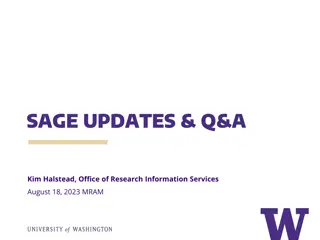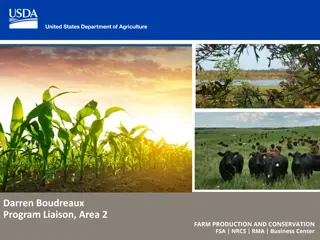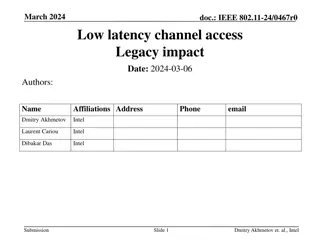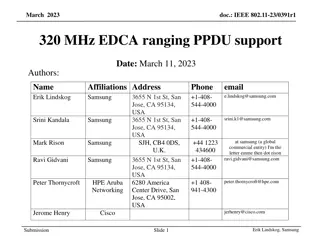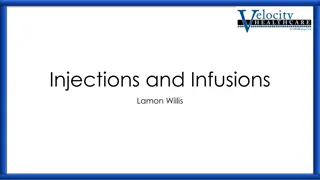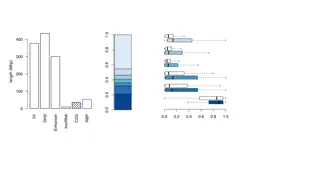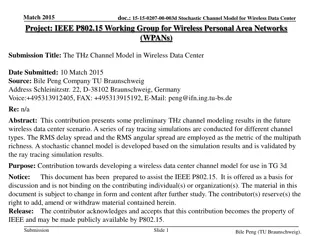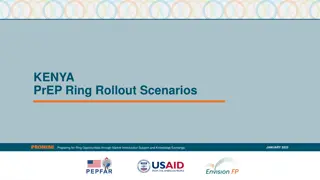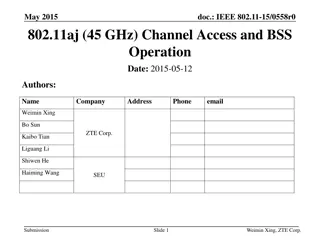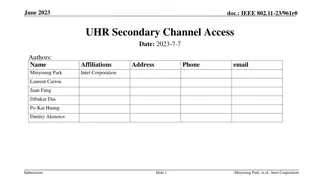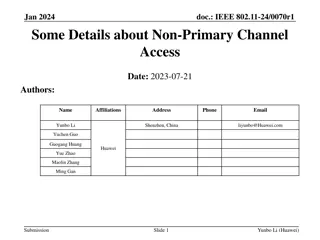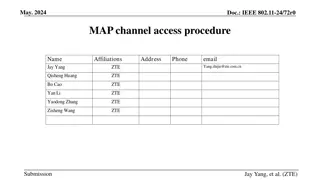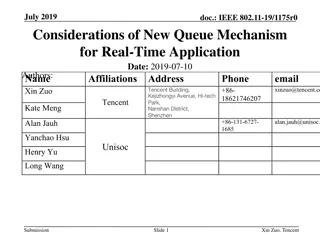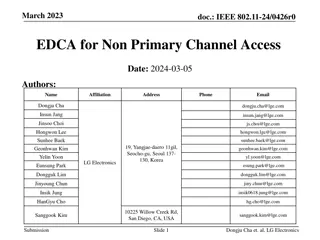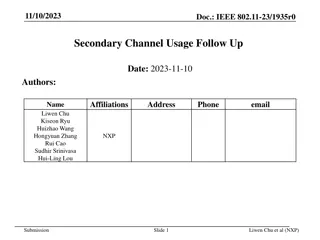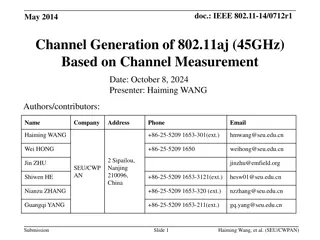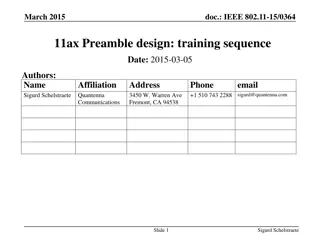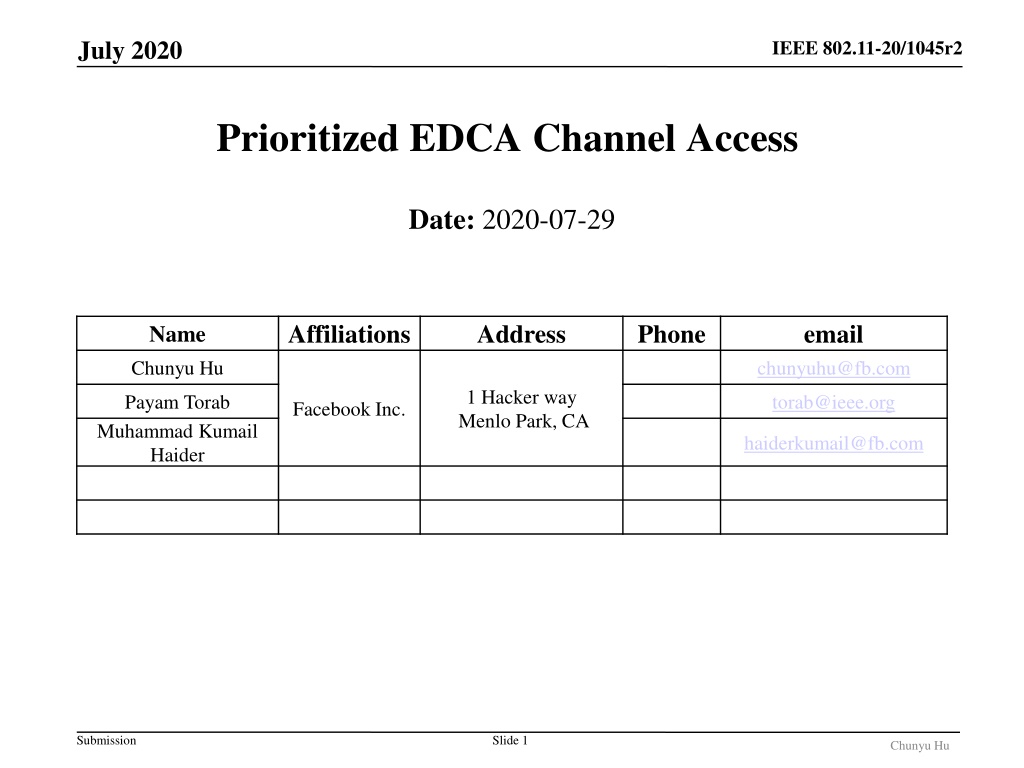
IEEE 802.11-20 Prioritized EDCA Channel Access Details
"Learn about the new medium access method in IEEE 802.11-20 for predictable and prioritized channel access. Explore the time slot structure, periodicity, and definitions for effective communication."
Download Presentation

Please find below an Image/Link to download the presentation.
The content on the website is provided AS IS for your information and personal use only. It may not be sold, licensed, or shared on other websites without obtaining consent from the author. If you encounter any issues during the download, it is possible that the publisher has removed the file from their server.
You are allowed to download the files provided on this website for personal or commercial use, subject to the condition that they are used lawfully. All files are the property of their respective owners.
The content on the website is provided AS IS for your information and personal use only. It may not be sold, licensed, or shared on other websites without obtaining consent from the author.
E N D
Presentation Transcript
July 2020 IEEE 802.11-20/1045r2 Prioritized EDCA Channel Access Date: 2020-07-29 Affiliations Address Phone email Name Chunyu Hu chunyuhu@fb.com 1 Hacker way Menlo Park, CA Payam Torab Muhammad Kumail Haider torab@ieee.org Facebook Inc. haiderkumail@fb.com Submission Slide 1 Chunyu Hu
IEEE 802.11-20/1045r2 July 2020 Abstract Background: new medium access method to provide more predictable, and prioritized channel access (11- 20/408r6) This contribution provides more details on channel access design, and associated signaling. Submission Slide 2 Chunyu Hu
IEEE 802.11-20/1045r2 July 2020 Time Slot Structure The time is divided into slots of fixed, and configurable duration Ts o The duration Ts is intended to be at txop level of granularity, long enough to hold one or more data frame exchange: rts/cts/a-mpdu/ba. o Slot boundary is at time Ts, 2*Ts, ., (time satisfying (TSF % Ts) == 0) o This provides a scalable way to represent medium/schedule status and can be conveniently described using a bitmap format E.g. a service period (SP) can be represented by a consecutive number of slots AP can share medium status or schedule info in slot bitmap format Good for both intra-BSS and inter-BSS coordination Beacon Beacon Beacon Ts ... ... time SP (Service Period) Submission Slide 3 Chunyu Hu
IEEE 802.11-20/1045r2 July 2020 Periodicity The link may be able to share a common, periodic interval T, composed of fixed, and configurable number of slots. Interval boundary is at (TSF % T == 0). o Example: two periodic streams with respective intervals: 16 TUs and 14 TUs AP can use an interval of 112 TUs o Pros: Help non-AP STA to predict slot occupancy without receiving the beacon before contending for the medium Simplify the checking overlap / over-subscribing the utilization of a slot Beneficial for applications of similar characteristics o Con: not realistic/practical all the time it may require a very long bitmap. E.g. T1 = 200 TUs, T2 = 300 TUs and Ts = 1TUs. Usually it s difficult to do so if one stream has small interval and the other has large interval high/low bandwidth traffic Propose: define maximum slot bitmap size, e.g. 256 bits. If possible to derive a common period T = N * Ts with N limited to maximum size, then AP can indicate if the schedule/slot bitmap info is repetitive/persistent Submission Slide 4 Chunyu Hu
IEEE 802.11-20/1045r2 July 2020 Definitions Example where a period T is assumed: three non-AP STAs and one AP. Terms: o P-slot: a slot is called P-slot if any STA has requested AP to assign the slot for prioritized access. o R-slot: A slot is called R-slot if none of STA has requested this slot. o MP-slot: from a STA s perspective, if the slot has been assigned to this STA (there can be multiple STAs assigned to the same slot however.) o OP-slot: from a STA s perspective, it is not registered for this P-slot s membership. Submission Slide 5 Chunyu Hu
IEEE 802.11-20/1045r2 July 2020 EDCA Parameters and Terms Default EDCA parameters: used by regular traffic for channel access. A second set of EDCA parameters: used by P-traffic to access P-slots. Called P- EDCA params. Regular traffic (R-traffic) uses a backoff timer, timer-1, to access the channel. Prioritized traffic (P-traffic) uses a second backoff timer, timer-2, to access the channel during P-slots. Alternative AIFS (A-AIFS): AIFS value used by timer-1 during P-slots to determine if channel has become idle to resume counting down. Submission Slide 6 Chunyu Hu
IEEE 802.11-20/1045r2 July 2020 General Descriptions AP advertises the following parameters: o Slot duration: S TUs. E.g. , 1, 2, 4 TUs o Interval T: T = N slots o P-EDCA params o A-AIFS o Any additional TBD parameters as needed. AP advertises the above info in Beacons, Probe responses and applicable management/action frames. Each STA can request assignment of slots for DL/UL/p2p traffic. The STA can request multiple contiguous number of slots. A slot can be assigned to multiple STAs to conduct MU operation. o A group of contiguous slots forms a service period (SP). o Details of slot management are in a separate contribution. Submission Slide 7 Chunyu Hu
IEEE 802.11-20/1045r2 July 2020 Channel Access: General Principal T T Assumed P-traffic pattern: o Periodic o Bursty: have packets ready at beginning of their MP-slots o Traffic amount may vary due to fluctuation in application as channel/rate dynamics Provide P-traffic prioritized access during P-slots Handle certain range of traffic amount variants of P-traffic in each interval 1. Protect beginning of a SP: tolerate small variants of time packets being ready 2. Protect SP period when bursty P-traffic is undergoing: A-AIFS for R-traffic and default EDCA parameters 3. Release SP period automatically when bursty P-traffic completes without requiring explicit signaling time start In burst complete 1. 2. 3. time Submission Slide 8 Chunyu Hu
IEEE 802.11-20/1045r2 July 2020 Backoff Behavior for R-Traffic When there is no P-slots: o When no STAs register any slot at AP, that is, there is no R-slots, then regular traffic access the channel following default EDCA access using default EDCA parameters. The channel access is not different from existing EDCA behavior. When there are some P-slots: o Regular traffic is not allowed to start transmission during a time window X usec before entering the P-slot boundary, and Y usec after the boundary. X, Y TBD, advertised by AP. Y usec X usec P P P time o If timer-1 is running, then suspend timer-1 X usec before the illustrated slot boundary, and can resume Y usec after the slot boundary. If medium is busy not due to its own transmission, then the slot is deemed as occupied (assumingly by its registered member), and the STA shall give priority to it to that end, until the STA successfully win the medium, it uses a newly defined A-AIFS to decide if medium has become idle and resume timer-1 counting down. o If timer-1 counts to 0 but didn t have sufficient time for its transmission due to R->P slot boundary, re-generate backoff from CW. Submission Slide 9 Chunyu Hu
IEEE 802.11-20/1045r2 July 2020 Backoff Behavior for Prioritized Traffic Medium access to MP-slots o In general, timer-2 is not run and is suspended out of MP-slots. When MP slots start, timer-2 resumes (or reset CW to CWmin, and generate a new backoff value from current CW. TBD). o Packets from P-traffic are transmitted using timer-2 during MP slots. If the STA doesn t have any packets from P-traffic any more, it can use timer-1 to contend medium access for its regular traffic as described in previous sections. o If the P-traffic for the current interval didn t complete when MP-slots end, the STA may still transmit them, but follows the medium access rule for regular traffic. Medium contention among STAs sharing the same SP / MP-slots o The slot(s) can be assigned to a) a non-AP STA for its DL and/or UL traffic, b) multiple non-AP STAs for their DL and/or UL traffic, or c) peer-to-peer transmissions. o STAs that have registered the slots membership contend medium access among themselves. To further mitigate the contention and reduce collision, the STAs can use any applicable mechanisms. For example, AP can use trigger frames to manage both DL and UL transmissions if the non-AP STA supports it. For another example, AP can use triggered P2P transmission procedure [11- 20/813r6] to coordinate the peer-to-peer communication. Submission Slide 10 Chunyu Hu
IEEE 802.11-20/1045r2 July 2020 Slot Boundary (1) For regular traffic: o Regular traffic shall stop at a slot boundary when a slot transits from R-slot to P-slot. o If the regular traffic wins the medium access during P-slots, its txop shall stop at the slot boundary, unless it knows the next slot belongs to the same STA(s) as the current P-slot. AP provides additional slot bitmap info for this purpose. Txop by regular traffic case 1 case 2 case 3 (a) (a) (a) (b) (b) (b) (c) (c) (a) (a) (a) (b) (b) (b) (c) (c) time Submission Slide 11 Chunyu Hu
IEEE 802.11-20/1045r2 July 2020 Slot Boundary (2) For P-traffic: o When transmitted during the MP-slots, the current txop shall end at the boundary of MP OP slot. o When transmitted during the MP-slots, the current txop should end at the boundary of MP R slot, but is allowed to extend to next slot (but not beyond.) o When transmitted during R-slots, follow the regular traffic rule. Txop by P-traffic case 1 case 2 (a) (a) (a) (b) (b) (b) (c) (c) (a) (a) (a) (b) (b) (b) (c) (c) time Submission Slide 12 Chunyu Hu
IEEE 802.11-20/1045r2 July 2020 Support of Peer-to-Peer Communication The Peer-to-Peer communication can be prioritized as well Some examples of peer-to-peer links: o TDLS: either non-AP STA can request slot membership for their P-traffic, and follow corresponding channel access rules o Tethered link using P2P (GO/GC): GO as non-AP STA associated with the AP, and request slot membership for the P-traffic carried over the p2p link o Tethered link using SoftAP: similar to above Additional tools that can be used to mitigate contention and improve efficiency: o Trigger based access if SoftAP/GO supports it o Triggered P2P communication [11-20/813r6] Note: the slot assigned to the peer-to-peer communication, depending on supported frame sequence, may have to be limited to be exclusive to the peer-to-peer communication (not shared with other peer-to-peer links) Submission Slide 13 Chunyu Hu
IEEE 802.11-20/1045r2 July 2020 A Special, Simplified Configuration If all prioritized traffic falls into the following cases, then we can disable EDCA for regular traffic during P-slots completely and uses A-AIFS sensing to resume regular traffic after prioritized traffic completes. This simplifies design but sacrifices flexibility. o DL: AP transmits to associated non-AP STA o UL: AP uses trigger frame to poll UL packets o Peer-to-peer: DL : softAP/GO its associated STA(s) UL : SoftAP/GO uses trigger based for its UL traffic Use the newly defined trigger based P2P frame sequence Configuration: o Don t need a second set of EDCA parameters since all transmissions are initiated only by one designated STA. o A-AIFS: STAs with regular traffic use A-AIFS to determine if the prioritized access has completed early. o Only need existing backoff timer Submission Slide 14 Chunyu Hu
IEEE 802.11-20/1045r2 July 2020 Simulation BSS and traffic configuration: o 1AP and a number non-AP STAs o 4 non-AP STAs with P-traffic: period 16 TUs, DL 80Mbps, UL 20Mbps UL o Varying number of non-AP STAs with DL full buffer regular traffic: from 0 to 8 MAC/PHY Parameters o BW 80MHz, P-traffic nss2 mcs9, regular traffic nss2 mcs1 o Use rts/cts, BA win 64, amsdu: 2 msdus per A-MSDU P-EDCA Parameters o Slot duration S = 1 TU, X=50 usec, Y= 100 usec, A-AIFSN=9 o Schedule: 16 TUs 16 TUs 1 TU time Submission Slide 15 Chunyu Hu
IEEE 802.11-20/1045r2 July 2020 Compare Three Schemes Methodology: Compare throughput/delay of three schemes: o Default (AC-BE): default EDCA with all traffic using AC-BE o Default (AC-VO): default EDCA with P-traffic using AC-VO and R-traffic using AC-BE o P-EDCA: P-traffic uses AC-VO in assigned slots, R-traffic uses AC-BE Increase number of non-AP STAs with full buffer traffic Metrics: P-traffic delay, throughput Submission Slide 16 Chunyu Hu
IEEE 802.11-20/1045r2 July 2020 Simulation Results Delay (queueing + medium access) comparison for DL/UL P-traffic Observations: o P-EDCA reduces mean latency in DL by ~4ms and UL by ~5ms o Latency for default EDCA using VO increases as full buffer traffic stream increases, while for P- EDCA delay remains nearly unaffected o Full buffer traffic slightly increases UL latency as P-traffic uplink stream may collide with DL full buffer traffic. Slide 17 Submission Chunyu Hu
IEEE 802.11-20/1045r2 July 2020 Results Delay CDFs for P-traffic (6 full buffer non-APSTAs case) Main observation: o P-EDCA improves worst case of UL/DL delay compares to default EDCA AC-VO very effectively, showing the criticalness of distributing and protected prioritized access Submission Slide 18 Chunyu Hu
IEEE 802.11-20/1045r2 July 2020 Results Average DL throughput: Observations: o For P-traffic (left), both Default (AC-VO) and P-EDCA get 80Mbps. Default (AC-BE) cannot meet the throughput requirement as downlink access is shared equally between R and P traffic o For R-traffic, P-EDCA gets some penalty due to slot boundaries and A-AIFS. However, the gap between Default (AC-VO) and P-EDCA closes as the full buffer traffic increases Submission Slide 19 Chunyu Hu
IEEE 802.11-20/1045r2 July 2020 Slot Assignment To Traffic Stream Submission Slide 20 Chunyu Hu
IEEE 802.11-20/1045r2 July 2020 Various Scenarios at STAs At top level a traffic stream is classified per (RA, TA/DST) o slots can be assigned to a STA s DL/UL/P2P traffic o A STA may have mixed regular and latency sensitive traffic to/from it. See below. Wearable devices: a device is designed to run latency sensitive applications o all traffic originated from/to this STA are desired to be prioritized (there can be some small portion of application mgmt/control traffic) A general computing device is running two types of traffic that falls into two categories: e.g. use BE/BK for regular traffic, and VI/VO for latency sensitive traffic; and they do not overlap o In this case, traffic can be differentiated based on AC A general computing device is running multiple applications. Two of them are using the same VI, but one is latency sensitive (real-time interactive traffic, e.g. AR/VR), and one is regular (video subscription, e.g. Netflix) o (RA, TID1/AC) and (RA, TID2/AC) differentiate the access service provided to each of these flows, provided they map to different access priority Submission Slide 21 Chunyu Hu
IEEE 802.11-20/1045r2 July 2020 Proposal Associate each traffic stream classified per (source/destination, TID) with an attribute: L-marker o L-marker = 1: latency sensitive traffic, associated with whatever mechanism AP/network enables to differentiate from regular traffic o L-marker = 0: regular traffic Options for signaling: 1. When establishing BA session, indicate if the associated TID is desired to be served as latency sensitive traffic Cons: may still want to transfer without a BA session. If don t mind this limitation, could be a good option 2. Use a new IE containing a bitmap: Each bit, if set, indicates being mapped/requested to use prioritized service over regular traffic 3. Use a field as part of slot request/response handshake frames msb lsb L-mark indicator bitmap (b15...0) x ... x x x x Bit k = 1 indicating TID <k> is latency sensitive TC. Bit 15= mgmt; bit-14: all Submission Slide 22 Chunyu Hu
IEEE 802.11-20/1045r2 July 2020 Example: Queues @ AP (MSDU, UP, Flag_LS) RA = STA1 RA = STA2 RA = STA3 TID=7 L=1 TID=6 L=0 TID=5 L=0 TID=4 L=1 TID=7 L=1 TID=6 L=1 TID=5 L=1 TID=4 L=1 TID=3 L=0 TID=2 L=0 TID=1 L=0 TID=0 L=0 TID=3 L=1 TID=2 L=1 TID=1 L=1 TID=0 L=1 TID=7 L=0 TID=6 L=0 TID=5 L=0 TID=4 L=1 TID=3 L=0 TID=2 L=0 TID=1 L=0 TID=0 L=0 ... Queueing management w/ Scheduler AC3 AC2 AC1 AC0 P-slot for STA 1 Not-assigned slots, for regular traffic P-slot for STA 2 P-slot for STA 3 time Submission Slide 23 Chunyu Hu
IEEE 802.11-20/1045r2 July 2020 Slot Information Description Submission Slide 24 Chunyu Hu
IEEE 802.11-20/1045r2 July 2020 Slot Information A slot bitmap in slot request/grant/reporting frames o Share schedule info o Let non-AP STA know the available slots to sign up o Share with OBSS STAs Slot duration: can be , 1, 2, 3, 4, 5, 6 , TUs. Can use coded/calculated value (TBD). Period: indicate period in number of slots. = 0: non-periodic. Persistency: Two types of bitmaps: o Status bitmap: indicate occupancy, request or assignment: 1 bit per slot. o Information bitmap: 4 bits per slot [ p2p | OBSS | trigger-only | Full ] Full: the slot doesn t accept any new member. Trigger-only: this slot uses trigger-only frame sequence OBSS: this slot is occupied by OBSS traffic P2p: this slot is assigned to p2p traffic Submission Slide 25 Chunyu Hu
IEEE 802.11-20/1045r2 July 2020 An Example Format Design Information Bitmap Present (1 bit) Slot Dur (6 bits) Bitmap Len (9 bits) Period (10 bits) Persistence (6 bits) Status Bitmap (variable) Information Bitmap (optional, variable) LSB MSB Slot Dur (value a): Duration is calculated as (value + 1) * TUs. Another option: 2 ^ (a-1) TUs. Bitmap Len (value c): # of slots included in the bitmap. The status bitmap has ceil(c/8) octets. Information Bitmap Present: indicates if <Information Bitmap> is present. Period (value b): = 0 : non-periodic; > 0 : periodic with b slots as period Persistence: indicate number of TBTTs during which the indicated info is valid Status Bitmap: has ceil (c / 8) octets. The padding bits are set to 0. Each bit indicates the status of the slot: occupied or requested or assigned. Information Bitmap: has ceil (c / 2) octets. Every four bits for a slot: o Bits 3-0 : p2p | OBSS | triggered-only | full Submission Slide 26 Chunyu Hu
IEEE 802.11-20/1045r2 July 2020 Carrying Frames Reporting frames: o Beacon, probe response or any applicable reporting frame(s): AP advertise slot configuration (dur, period), status and information bitmaps. o Create slot info IE Slot request/response frames: o Create new action frames for handshake o Can be carried in TWT frames to request TWT schedule and slot access o In addition to slot information, has additional request/assignment info Slot termination frame or field Any applicable / TBD frames to conduct inter-BSS access coordination Submission Slide 27 Chunyu Hu
IEEE 802.11-20/1045r2 July 2020 Slot Requesting Frames <Slot Information> field setting: o Slot duration: shall set to same as AP s o Period: indicate period. = 0: once. o Status bitmap: indicates requested slots o Information bitmap: set <p2p> bit to 1 if requesting for tethered link <Slot Control> field: o Request type: New or change: replace existing schedule associated with this STA Add: additional slot request (existing ones remain) o Flexible slot offset indicator: o Exclusive indicator: indicate if okay to share slots with other STA(s) o <minSlots, minRU, minNSS>: minSlots: minimum number of slots requested assuming <minRU> and <minNSS> MinRU: minimum RU needed, in case OFDMA is in use MinNSS: minimum NSS needed, in case MU-MIMO is in use Submission Slide 28 Chunyu Hu
IEEE 802.11-20/1045r2 July 2020 Slot Utilization Monitoring AP monitors the utilization of slots, and may force release or change assignments Submission Slide 29 Chunyu Hu
IEEE 802.11-20/1045r2 July 2020 Summary Proposed a general channel access method and associated signaling to provide a more predictable latency / throughput performance o Operate on a time slot structure and support periodic traffic o Scalable approach for both intra-BSS and inter-BSS schedule coordination Can be used in combination with other power saving mechanisms such as TWT and U-APSD for example. Existing: Proposing: + U-APSD e.g. BCAST/Individual TWT + TWT pEDCA Time Slot structure Time Submission Slide 30 Chunyu Hu
IEEE 802.11-20/1045r2 July 2020 SP #1 Do you support that the TGbe SFD shall include (in R1): o An optional mechanism of dividing medium time into slots of duration TBD during which prioritized EDCA access operates for specifically allowed STAs Submission Slide 31 Chunyu Hu
IEEE 802.11-20/1045r2 July 2020 SP #2 Do you support that the TGbe SFD shall include (in R2): o An optional mechanism of dividing medium time into slots of duration TBD during which prioritized EDCA access operates for specifically allowed STAs Submission Slide 32 Chunyu Hu
IEEE 802.11-20/1045r2 July 2020 SP #3 Do you support that the TGbe SFD shall include (in R1) a channel access enhancement that provides a more predictable latency performance in R1: o Define prioritized access time period assigned for specifically allowed STA(s) o AP advertises and share all such prioritized access time period in a TBD resolution o TXOP shall end before start of any prioritized access time period Submission Slide 33 Chunyu Hu
IEEE 802.11-20/1045r2 July 2020 SP #4 Do you support that the TGbe SFD shall support (in R1): o A TBD signaling procedure that indicates a traffic stream classified per (source, destination, TID) carries latency sensitive traffic Submission Slide 34 Chunyu Hu
IEEE 802.11-20/1045r2 July 2020 SP #5 Do you support that the TGbe SFD shall support (in R1): o AP advertises prioritized channel time periods in TBD format that provides the utilization status as well as more detailed information. o A signaling procedure for AP to assign certain time period to requesting STA(s) o The time period is described using a TBD time slot bitmap format assuming the medium time is divided in TBD slot duration. Submission Slide 35 Chunyu Hu
IEEE 802.11-20/1045r2 July 2020 Backup Slides Submission Slide 36 Chunyu Hu
IEEE 802.11-20/1045r2 July 2020 Results Delay CDFs for P-traffic (6 full buffer non-APSTAs case) This difference is due to larger agg size in DL vs UL Explanation of some seemingly odds : o P-EDCA UL has lower medium access delay due to lower aggregation, resulting in lower mean latency. o In some cases, delay for Default (AC-VO) can be lower than P-EDCA due to smaller AMPDU length. Submission Slide 37 Chunyu Hu



